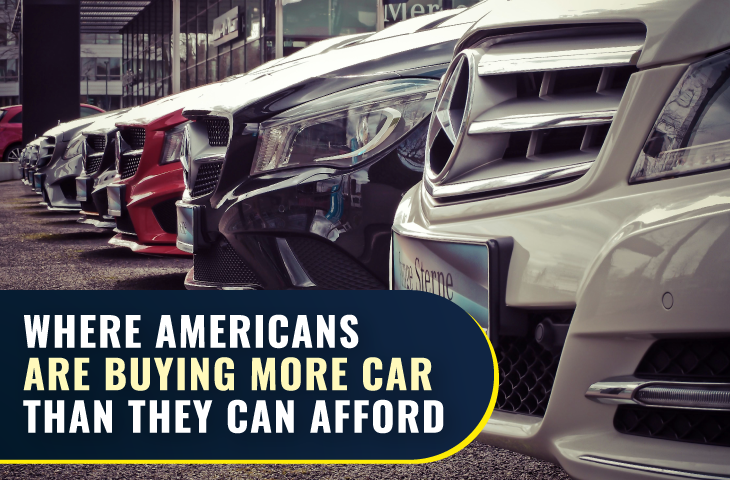
Written By: Jessica Anvar Stotz
Legally Reviewed By: Jessica Anvar Stotz

Car ownership has long been a status symbol in America, and for many, that means taking on more car than they can afford.
As auto loan balances and delinquency rates continue to rise across the nation, many Americans are carrying loan burdens alarmingly disproportionate to their income.
While auto debt is climbing nationwide, certain states stand out for their especially high loan balances and the percentage of auto debt to annual income, leaving residents strained financially.
This strain is especially concerning in states like Louisiana, Florida, and Texas, where vehicle loan balances are particularly high as a share of household debt.
This financial pressure becomes even more overwhelming for Americans who end up with a defective — or potentially a lemon — vehicle. In these cases, the support of the Lemon Law Experts can make all the difference.
Our attorneys specialize in helping owners of faulty cars secure the compensation they deserve. Even if you’ve taken on more car than you should, a defective vehicle shouldn’t add to your burden.
The Lemon Law Experts can help ease the financial strain and get you the resolution you need.
To identify where auto loans are hitting household budgets the hardest, the Lemon Law Experts analyzed data from The Federal Reserve Bank of New York, the U.S. Census Bureau’s American Community Survey (ACS), and the Bureau of Economic Analysis.
By comparing auto loans, income, vehicles per household, and regional price parities, we reveal where Americans are most likely to be overextending themselves to finance their cars.
Key Takeaways
- Louisiana, Florida, and Texas have the highest auto loan balances relative to income.
- Texas, Florida, and Louisiana hold the largest average loan balances per vehicle.
- The national average outstanding loan balance per vehicle is $6,671.
The States Where Auto Loans Stretch Budgets the Most
Our analysis used auto loan data from the Federal Reserve. We recalculated it as the average loan balance per vehicle using household vehicle data from the U.S. Census.
To make the comparison fair across states, we then adjusted for cost of living using regional price parities from the Bureau of Economic Analysis before calculating the percentage of auto debt to income for each state’s residents (debt-to-income ratio).
The highest loan burdens as a proportion of income reveal where Americans are overextending on cars.
For residents in Louisiana, Florida, and Texas, the average auto loan balance eats up a significant portion of their annual income.
Each auto loan accounts for over 12% of what the average household in these states earns annually. That figure is per car, so households with two or more cars have outstanding loan balances that are nearly a quarter of their annual income.
At the top, Louisiana residents have the highest share of outstanding auto loan balances as a proportion of income, even after adjusting for the cost of living.
The average loan balance per car in this state is a whopping 14.33% of adjusted median household income.
Close behind is Florida and Texas, with residents holding auto loan balances that are 13.39% and 12.88% of their income per vehicle.
On the other end, residents in Minnesota and Hawaii hold proportional auto loan balances that are half of Louisiana residents.
The average outstanding balance on each car in these states is just 6.4% and 6.73%, respectively. The more manageable debt-to-income ratio in these states indicates these residents are not overextending their finances to buy more car than they can afford.
However, both Minnesota and Hawaii are also closer in line with the national average. Each auto loan balance in the country averages 8.89% of adjusted annual household income.
The outliers are states like West Virginia, Mississippi, and New Mexico, whose residents all hold individual auto loan balances that are over 11% of income.
In other words, there aren’t many states that intentionally buy less whip than they can afford, but a few stand out for buying too much.
The States Taking on the Heaviest Auto Loans
While high debt-to-income ratios for auto loan balances point to the states that are overstretching their car budgets, the sheer size of auto loan balances can also be indicative of this.
The average outstanding loan balance per vehicle in the U.S. is $6,671, and some states are notable for holding far higher balances per vehicle.
The top three states holding the highest average loan balance per vehicle are the same states with the highest debt-to-income ratios for auto loan balances, just in reverse order.
Topping the list is Texas, where the average outstanding auto loan balance is $9,548 per car — more than $2,800 above the national average.
Florida follows with outstanding auto loan balances of $9,090 per vehicle, and then Louisiana with an average balance of $8,768.
These figures reinforce that in these states, residents are purchasing more expensive vehicles, regardless of whether we look at debt-to-income or the sheer volume of auto loan balances.
Meanwhile, residents in Montana, Wyoming, and Wisconsin display more modest vehicle purchases.
Montana residents take the top spot for buying less car than the national average, with auto loan balances averaging just $5,120 per car — over 23% less than the national average.
Wyoming and Wisconsin residents are close behind, with an average of $5,164 and $5,234 in outstanding loan balances per car.
These balances reflect more conservative spending on vehicles, even suggesting that residents in this state are buying less car than they can afford.
When Your New Ride Turns Sour
Cars are one of the biggest investments Americans make, and car loans are a significant financial burden.
If a vehicle doesn’t live up to expectations due to unreliability or defects, that burden can be even greater, costing Americans time, money, and stress.
Consumers who wind up with defective vehicles or lemons deserve compensation, but navigating difficult lemon laws can take extraordinary time and energy.
It’s bad news if you have a lemon, but the good news is that the Lemon Law Experts are here to help.
With offices throughout California, including Los Angeles, San Diego, and San Jose to name a few, we specialize in helping consumers across the state of California navigate the California Lemon Law to recover the compensation they deserve.
Recently, we expanded our practice to Texas and are now providing our services to consumers across the state of Texas with lemon law claims.
The Lemon Law Experts are your best resource for swiftly resolving your case, minimizing the stress and time that naturally arises if one of your biggest investments — your car — malfunctions.
Methodology
In September 2024, we set out to determine where in America people are spending more on their cars than they should.
To answer this question, we conducted two analyses with equitable and nuanced findings. We found the U.S. states with the highest average outstanding auto loan balances per vehicle and the states with the highest auto loan balances as a share of income (adjusted for cost of living).
Both analysis types provide insights into the U.S. states that are spending the most on vehicles, often more than they can afford.
How We Calculated Average Loan Balance per Vehicle
To find the average outstanding auto loan balance per vehicle, we used the latest average car loan balance per capita from The Federal Reserve Bank of New York and the number of vehicles available per household from The U.S. Census Bureau: American Community Survey.
We reversed the loan per capita statistics and recalculated the data per vehicle.
How We Calculated the Loan Balance to Income Ratio
To find the states with the highest auto loan balances as a proportion of income, we used our calculated auto loan balance per vehicle finding in conjunction with the latest data on median income from The U.S. Census Bureau: American Community Survey and Regional Price Parities (RPP) from the Bureau of Economic Analysis.
To provide a more equitable analysis, we adjusted median income using regional price parities before calculating the loan-to-income ratio.




